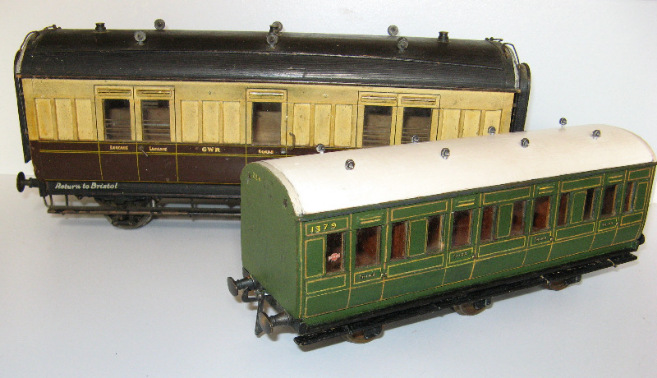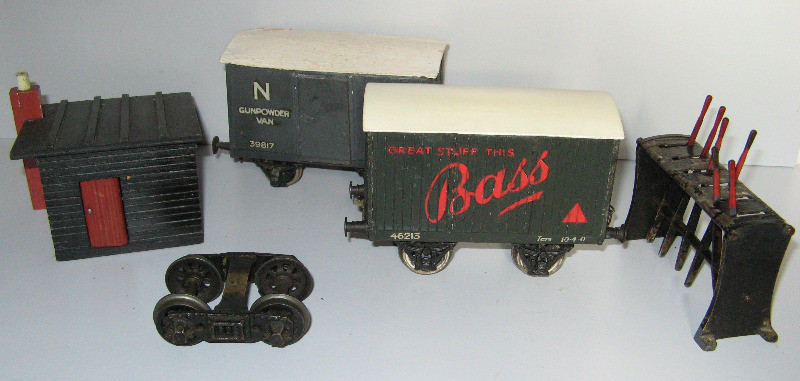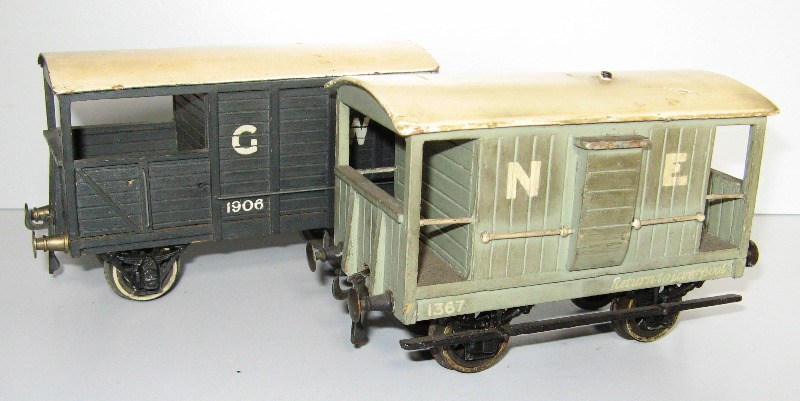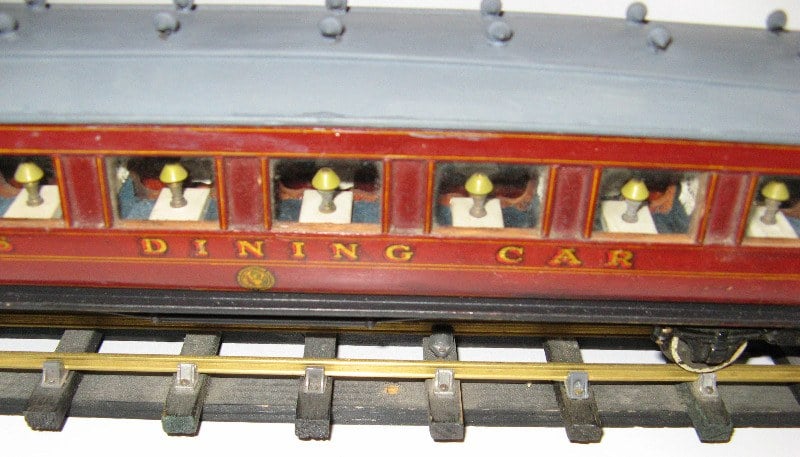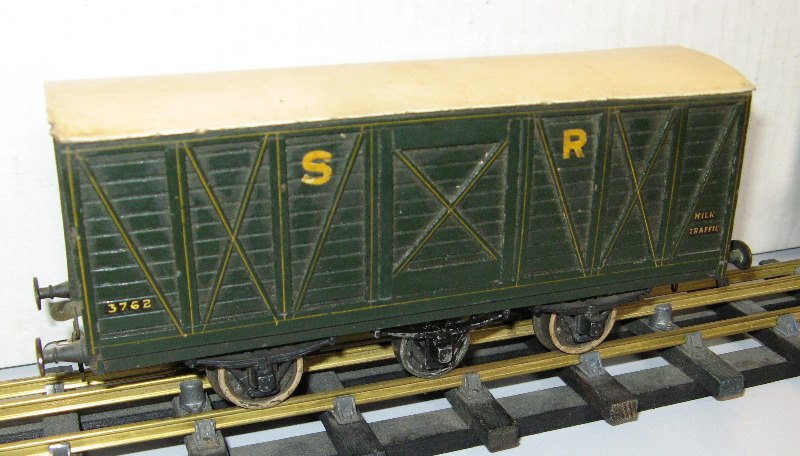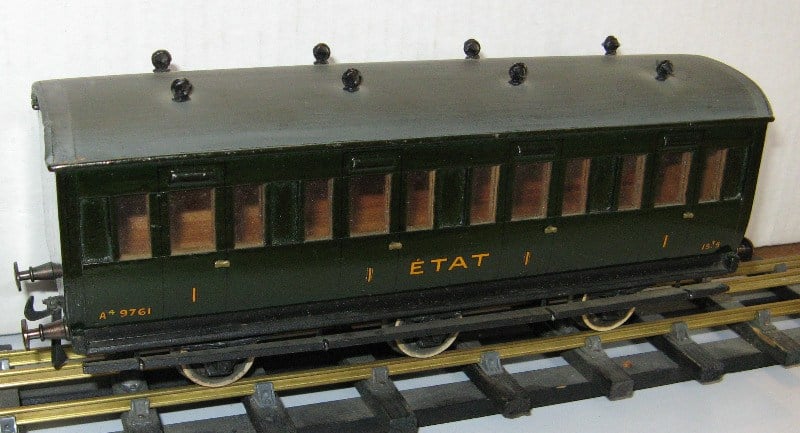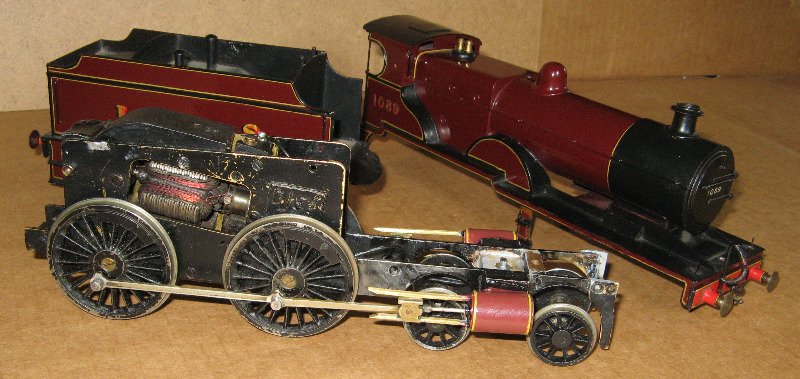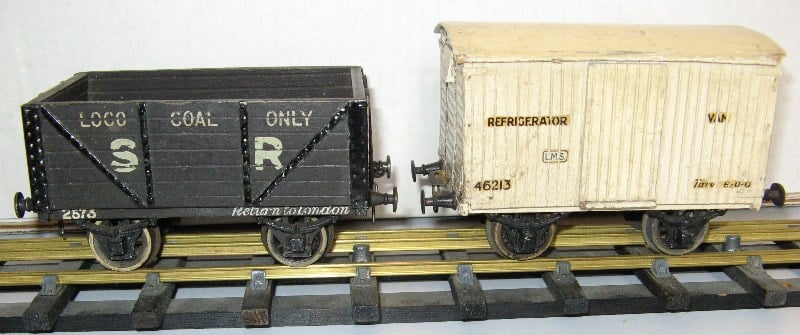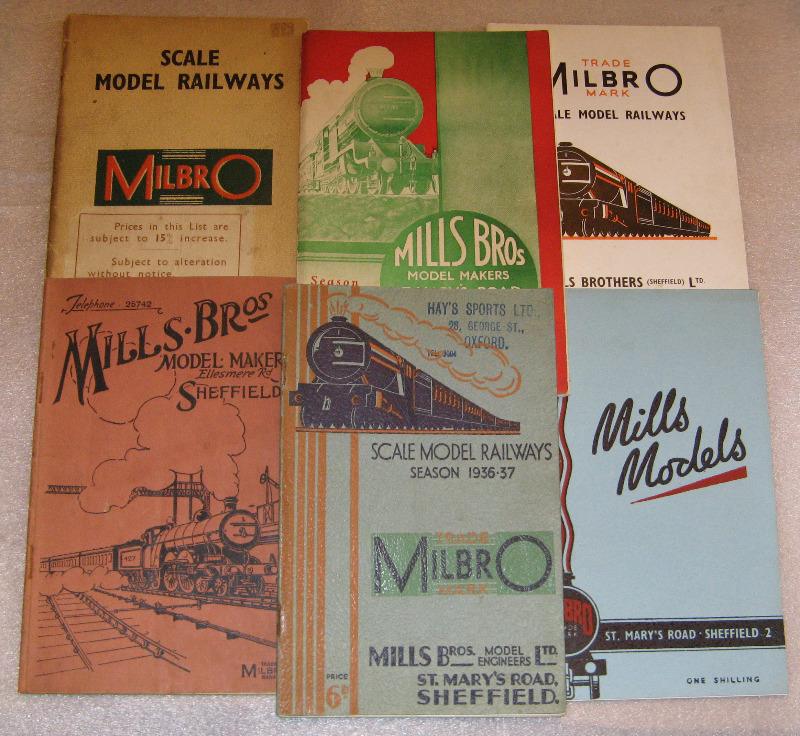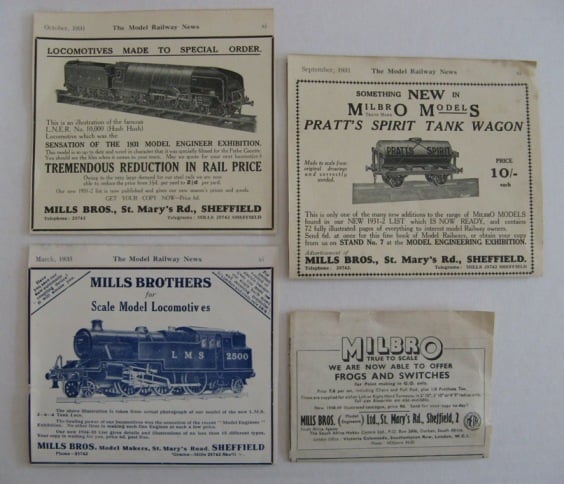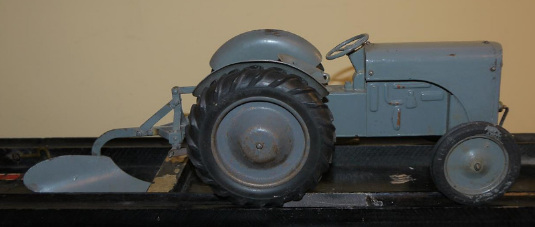
Introduction to Milbro trains
****The material in this section was revised most recently in March 2025****
Milbro trains; introductory illustrations and comments
Copyright is retained by M.L.Harrison for all text and photos, except for those taken by other owners and enthusiasts.
M.L.Harrison 2020, 2025 © All rights reserved.
For anyone unfamiliar with Milbro models, some initial pictures may help set the scene. One or two items shown below are in ‘well used’ condition, like many that turn up on the internet or in auctions.
Illustration 2 GWR and SR 6-wheel wooden vehicles (gauges 1 & 0). Windows are made of glass.
Illustration 3 ‘Bass’ private owner box van and NE gunpowder van (0 gauge),with lineside hut, lever frame, and a brass wagon bogie. Illustration 4 Early example of NE brake, as catalogued, with a standard GWR brake standing behind (0 gauge). The company also made a brown version of the NE vehicle.
Illustration 5 LMS restaurant car side, showing interior details (0 gauge). Illustration 6 SR 6-wheel milk van (0 gauge). See also the Gallery section for some similar vehicles in other liveries. Illustration 7 Continental 6-wheel coach (0 gauge).
Illustration 8 LMS 4-4-0 compound loco (0 gauge). This shows the company’s earlier type of mechanism, and the very distinctive features of the Milbro compound loco body as catalogued, which differ from the full-size prototype (although the running number here is not the same as in the catalogue picture). When this photo was taken restoration was ongoing. Updated pictures appear on our Home Page and in the Mills locos page.
Illustration 9 SR open wagon from early post-grouping production period, and LMS refrigerator van. Van needing some repairs. The wagon as shown here unfortunately had lost the transfers from its other side, and the 'Loco Coal Only' ones on the visible side had been substantially eroded. In 2025 this vehicle was restored using original Mills Loco Coal transfers, and can be seen in that form in our Mills Wagons section. The colour is not captured well above, and is actually a very dark brown.
Illustration 10 Some Milbro catalogues, showing variation in cover styles. Background; model railways, enthusiasts and collectors Interest in railway models has had a long history in Britain, sustained in part through links to engineering traditions and large-scale employment in transport industries in earlier periods, as well as by the success of trains as toys and the popularity of railways amongst school-boys in past decades. Alongside individual enthusiasts, numerous organisations owned model railways or sponsored and hosted these, with model railway or engineering clubs providing facilities for collaborative construction and running. Particular institutions, including some schools, sometimes also had model railway societies or activities[i]. The extent of model railway activity over many decades is reflected in the large numbers of locomotives and rolling stock that can be seen today; at fairs, shows and other events, in auction sales, and on the internet. In recent years the internet has made it easier to purchase old railway models. For vintage trains and toys generally, there is a wide array of objects available through Ebay, in dealer advertisements, or via online bidding with auction houses such as Vectis, SAS, or Stop the Drop. These channels have facilitated or stimulated some kinds of collecting, just as toy and train fairs have done. Enthusiasts who collect, renovate, build or run model railway items today give many reasons for their involvement. Nostalgia plays a part, alongside admiration for fine workmanship and engineering, as well as the collaborations, comradeship and shared memories that often help bring hobbies to life. Collecting sometimes also has further motivations, including the enjoyment of discovering and repairing things that are hard to find, the excitement of the auction room, or the development of historical knowledge. Alongside this, many enthusiasts enjoy operating toy trains, and maintaining or putting in order old engines or rolling stock. For vintage ‘0’ gauge trains, the larger communities of collectors of British items since the 1970s have probably been those interested in Hornby, Bassett-Lowke and the Leeds Model Company, while Exley coaches have also had a substantial following. There is a significant group of enthusiasts too for the live-steam models made by Bowman. Some enthusiasts today collect and run trains from a variety of manufacturers, while modern items by Ace, Corgi/Bassett-Lowke or Darstadt may stand alongside older ones. Overseas manufacturers contributed substantially to what was sold in the UK in previous periods, not only under their own brand names but as suppliers for companies such as Bassett-Lowke, and overseas production remains important today. With British-made products, the less common vintage locomotives and rolling stock from firms such as Bonds and Milbro feature in some people’s collections, and Mills wooden wagons and coaches seem fairly widely recognised. Collecting Milbro trains There is far less published information about Milbro than about the Leeds Model Company (LMC)[ii], Bassett-Lowke[iii] or Hornby[iv], and general reviews of vintage toy trains give sparse attention to Mills examples[v]. Nonetheless, there seems to be quite strong interest amongst some of today's collectors. One interesting indicator has been the development and sale of suitable reproduction transfers for Mills wagons. While Milbro items that are relatively common or in poor condition will not fetch high prices amongst traders or at auction, the rarer or best preserved items certainly can do so. There is often also some scope for repair and renovation with Mills rolling stock, a factor that might attract modellers who enjoy such challenges. Before World War Two Milbro would have been fairly well known amongst UK model railway audiences. The company advertised regularly in The Model Railway News, sometimes taking half a page and including pictures of particular products. In September 1931, for example, their advertisement featured a 4-wheel spirit wagon (MRN, 7, 81, xi). There was also reference to the company’s stand at the Model Engineering Exhibition, and to the '72 fully illustrated pages' that could be studied in their 1931-1932 list.
Illustration 11 Examples of Mills advertisements taken from model railway magazines
A search on the internet today can reveal a variety of mentions of Milbro, with references to several types of products other than models, and more than one company having used the name (including a company producing motors for model planes and one making fishing tackle). The present website will not say much about Milbro beyond the model railway items produced by the Sheffield-based company, and referred to in the familiar catalogues. Specific non-railway models, however, could also be commissioned from that same company, and one important and intriguing example will be mentioned when post-war production by the firm is discussed in our section on Milbro locomotives. This is a model tractor (one of a batch made in Sheffield). I am very grateful for explanation, history and photographs provided on this item by a very knowledgeable informant. One of his images is shown now, and others may be found in the Locomotives and Artwork sections of this site [vi].
Illustration 12 Model of a tractor produced by Mills in the 1940s. See also the website sections on Locomotives and on Artwork. I have been informed that a batch of these models was commissioned from Mills by a tractor company, and they were supplied to main dealers so that salespeople could use the model to demonstrate specific safety features.
Mills locomotives and rolling stock were by no means cheap, and the locomotives probably sold in rather modest numbers. Certainly, the market for Milbro's best locomotives would have been narrow, but there were some purchasers who could afford the most expensive of the models produced by Mills, Bonds, Bassett-Lowke, and other companies. Over quite a long period, model railway enthusiasts included not only those from engineering or transport backgrounds, or the ‘scratch builders’ and kit builders who collectively often kept the hobby afloat, but also some wealthy collectors who commissioned the building of expensive models to very high standards. Such collectors ranged from owners of businesses to high status professionals, military officers or people prominent in other domains of social and economic life[vii]. Past issues of the Gauge 0 Guild Gazette (published by the Guild from the 1960s onwards) offer many examples of the backgrounds or status of people involved with model railways (see for example 1965, Volume 2 [12], p. 8). One amusing anecdote republished by the Guild recounted the visit of a war-time intelligence official to an Air Vice-Marshall, during which the release of some Mosquito aircraft was preceded by discussion and examination of railway models (1982, Volume 8 [7], p. 31). Sometimes people who have bought very expensive ‘off the shelf’ or ‘special order’ engines have been characterised as ‘cheque-book modellers’ by enthusiasts who build their own locos. Those who commissioned high quality models in earlier periods, however, contributed importantly to the pool of excellent items from which interesting collections can be built up today (even by those with far more modest resources). My first Milbro item was purchased in 1990, but some model railway enthusiasts have been involved with Mills trains far longer than I have. Milbro collecting for me focussed primarily on 0 gauge wooden wagons which used to be relatively inexpensive to buy, especially when needing repair. Trying to put some of these into better order helped me become familiar with their features and construction. I am grateful to the Bassett-Lowke Society for encouraging me to publish some detailed investigative articles about these wagons in the society’s journal a few years ago[viii]. I have not yet come across anything published which deals in a similar way with the company’s locomotives or coaches, so I have assembled gradually as much material as I could about the locos and the range of coaches. Work on the wagons section of this site was easier for me to do, and much of that material became available to view from March 2014. I continue to add to sections of the site when something seems useful, and when time allows. I have had lots of help, and this is acknowledged in the Home Page.
[i] See for instance Gauge 0 Guild Gazette, 1966, 3 [1], p. 10. A well-known toy and model dealer recently (at time of writing) handled an important model railway that had originally been owned and run by a school, and a turntable from this source is shown later in the section on 'other items'. [ii] The key source for understanding LMC’s development and contributions is David Peacock’s book, The Leeds Model Company 1912-2012: The First One Hundred Years, an appreciative history (Bucks: Peacock, 2011). See also the website of the Leeds Stedman Trust (see Link on our Home Page). [iii] For Bassett-Lowke note especially Fuller, R., The Bassett Lowke Story (London: New Cavendish Books, 1984), the issues of the Newsletter of the Bassett-Lowke Society, and De Chastelain, G., Bassett-Lowke: The gauge 0 Locomotives (Bucks: De Chastelain, 2013). The latter presents an impressive array of model locomotive photographs. [iv] Numerous publications deal with Hornby, including Graebe, C. and J., The Hornby Gauge 0 System (London: New Cavendish Books, 1984). [v] For systematic general information on a range of companies’ products (including Milbro), readers can consult the various editions of Ramsay’s British Model Trains, compiled by P. Hammond (Bourne, Lincolnshire: Warner Group). Numerous other modern publications contain excellent accounts and photographs of vintage trains including those made in the UK. Notable authors here include Levy, A., Carlson, P., McCrindell. R. , Marsh, H., and Gomm, P., but specific coverage of Milbro is very limited from these sources. [vi] It seems that another model of a tractor was also commissioned for an Australian institution. [vii] See especially Bassett-Lowke’s clients and contacts mentioned in Fuller, R. (cited above), pp. 347-348. For examples of a wide range of enthusiasts and their railways see Ray, J., Fifty years along the line, 1956-2006, the Golden Anniversary of the Gauge 0 Guild (The Gauge 0 Guild , 2006). See also Ganderton, R.A., James Stanley Beeson, 1906-1990 (Poole: Faculty Publishing, 1999). Model railway journals have included numerous articles featuring specific collections, and a few of these illustrate what must have been very expensive railways containing ‘professionally-built’ detailed locomotives. Sometimes these were running alongside items made by owners themselves (see for instance coverage of Alan Shackleton’s railway in The Railway Modeller, December 1952, April 1953, August 1953, September 1953, etc.). [viii] Autumn 2004 (14, 1, pp. 22-26); Spring 2007 (17, 1, pp. 18-20); Summer 2007 (17, 2, p. 26).
|
